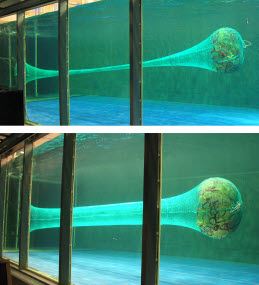
|
The greater the cross-section the codend has, the less turbulence it causes. And the lesser the turbulence, the gentler it is on the catch. These photos from SINTEF’s flume tank in Hirtshals show the difference between a traditional codend (above) and one with the net turned 90 degrees (below). Photo: SINTEF Fisheries and Aquaculture |
Hansen, who is Danish, is a senior research scientist at SINTEF’s North Sea Centre Flume Tank in Hirtshals in Northern Denmark. Trawling boat owners in three major fishing nations have taken a fancy to his solution.
A large proportion of the trawling fleets fishing off the coasts of Iceland, Scotland and New Zealand have now adopted his idea. Trawler owners in other countries around the world are also following suit.
This should not come as a big surprise given that Hansen’s “90 degree turn” has unveiled a variety of benefits for the trawling industry.
A gentler catch
As a fisheries researcher, Hansen was well aware that fish which were trawled were often damaged in the codend, the trawl’s rear part. Underwater videos have revealed the reason for this: Turbulence occurs around today’s codends, causing them to swing from side to side.
When Hansen and his colleagues commenced their work on a new trawl design, they had an ambition: To develop a trawl that does not cause turbulence and, as a result, would be gentler on the catch.
In simple terms, the aim was to develop a trawl in which the meshes in an outstretched position remain as wide open as possible. It is precisely this aspect which leads to turbulence.
And the winner is…
Using a 1:2 scale, Hansen and co tested 13 trawl models of differing design in the flume tank, one of which had its net turned 90 degrees. This is the model which emerged victorious from the tank.
The cross-section was 12 times greater and the swinging movements were dramatically reduced compared to traditional codends.
Pleasant side effects
The original objective of a gentler handling of the catch had now been achieved. But the success did not stop there.
When the “90 degree turn” was tested at sea, including by commercial trawling fleets, a series of additional benefits emerged.
More fish and less small fish
All the newly discovered benefits can be attributed to one condition: When the net is turned 90 degrees, the meshes remain open when the trawl is stretched. In contrast, the meshes on a traditional trawl close when stretched.
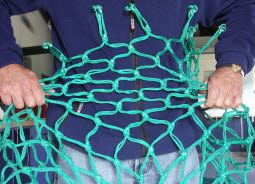
| 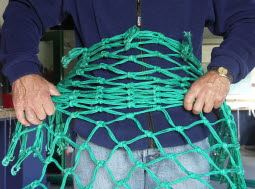
|
The meshes in a codend with a net turned 90 degrees remain open even when the net is stretched. The net shown can be utilised when trawling for cod and coalfish. | This is what happens with a traditional net when the codend is stretched. Compared to the meshes in the T90, these meshes are virtually closed. |
Hansen and co have received a lot of positive feedback from the testing at sea. Codends with their nets turned 90 degrees catch both more and larger fish than their traditional rivals. This results in part from the fact that the open meshes carry more water through the trawl.
More selective
The new codend has also proven to be more selective than traditional trawls. The trawl releases unwanted small fish to freedom through the remaining opening in the meshes, much to the delight of biologists and environmentalists.
The small fish escape in much better condition that small fish which slip through the net of a traditional trawler, Hansen says, adding that the open meshes also ensure shells and other rubbish are washed out of the codend.
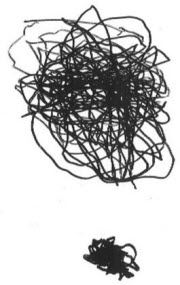
|
The proof that different trawl designs generate different degrees of turbulence: These ”plots” show how the two bags move in the water: a traditional trawl (above) and a trawl featuring T90 meshes (below). Photo: SINTEF Fisheries and Aquaculture |
The “sensible codend”
“The whole thing has been a win-win-win situation,” he says.
Trawlers in Iceland have dubbed the new codend the “sensible codend”, while in New Zealand it has become known as the “turbo trawl”. The official name is T90, an abbreviation of “90 degree turn”.
Hansen explains that it is possible to utilise the turned net in the entire trawl or in large or small parts of it.
“The trawler owners are free to utilise the phenomenon and derive its benefits as they see fit,” says the SINTEF researcher.
Inspiration from Poland
Hansen will not accept all the credit for the “90 degree turn”.
“However, I am the one who has revealed some of the characteristics of the T90 solution. I have also been in the position where I have been able to convey the results effectively to the industry,” says Ulrik Jes Hansen.
When the research and develop project began, the idea was to test out 12 new designs. Hansen then read about a Polish researcher who had calculated the force distribution of a trawling net. That gave him the idea of adding a 13th model featuring a net turned 90 degrees.
”For once, 13 has proven to be a lucky number!”
New start after collapse
When Hansen and co began work on the new trawling net, the flume tank was still under the management of the Danish Institute of Fisheries Technology and Aquaculture (DIFTA). The laboratory went into liquidation, meaning the project had to be put on hold for a while.
When SINTEF took over the laboratory, they got the chance to continue their work on the T90 solution.
There have, however, been some critical voices among all the jubilation. In Sweden, some have claimed the meshes in the trawl will begin to close after a given time because the knots in the net will become turned.
“This suspicion is baseless,” says Hansen. “And this criticism has also been rejected by studies carried out in Germany.”
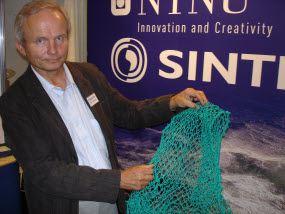
|
Senior Research Scientist Ulrik Jes Hansen has shown the trawling industry the benefits they can derive by turning all or part of the trawl net. This photo was taken at this summer’s Norfishing trade fair in Trondheim. Photo: Svein Tønseth |
By Svein Tønseth
